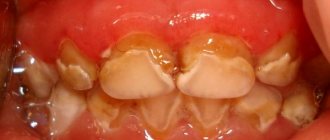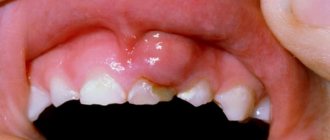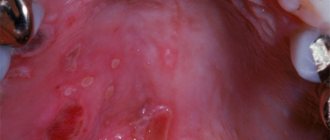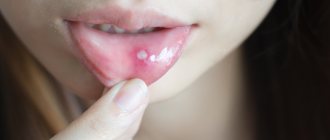Why do you need a diet for stomatitis?
In patients with severe pain, eating is difficult. The unpleasant sensations are especially pronounced in lesions of an ulcerative-necrotic nature, when the oral cavity has deep lesions. Consult a doctor! The dental clinic will develop a therapeutic program for each patient. When the mouth is in this condition, the patient may refuse to eat, which has a detrimental effect on health. After all, the body spends a lot of energy when it is sick. It is needed to maintain body temperature, the production and release of active agents, and the synthesis of antibodies. That is why it is important to eat right and replenish lost nutrients. However, the diet must be correctly composed; not every product should be included in the menu.
When to see a doctor
Determining the type of disease in young children is the doctor’s task. The disease may begin with symptoms of ARVI, show signs of intoxication, lymph nodes may become enlarged (herpetic type) and nausea and vomiting may appear - these are reasons to consult a doctor so that stomatitis at 2 years of age can be treated correctly for a child, taking into account age. To prevent recurrence, it is recommended to strengthen the immune system, monitor oral hygiene and consult a doctor at the first symptoms.
General rules of nutrition for stomatitis
The nutritional rules for this disease are not complicated, but require careful implementation. The set of standards includes:
- Meals should be fractional.
- If you have stomatitis, you can’t eat three times a day, it’s not physiological. With this regime, the gastrointestinal tract is overloaded.
- Food is taken every 3 hours; you need to eat 5-6 times a day.
- Gentle nutrition does not irritate the mucous membrane and does not cause pain.
- Products should be crushed as much as possible. Meat and fish are processed into minced meat, berries and vegetables into puree.
Sour fruits are prohibited, as they provoke the development of bacteria. Increased sensitivity of the mucous membrane does not allow the use of spices and sauces. Alcoholic drinks and pickles are excluded from the menu so as not to provoke pain or discomfort. Bitter and sweet foods should also not be consumed.
Heat treatment
But with stomatitis, you can eat dishes that have been heat-treated. This is not only not harmful to the inflamed oral cavity, such food is beneficial for the whole body. After boiling or stewing, the food should cool down. Its optimal temperature during administration is from 37 to 40 degrees. Slightly warm foods are the same temperature as the body. The priority is vegetable soups, casseroles, and purees. Many delicious dishes can be prepared if you use this culinary method, stewing. You need to avoid foods that are too cold or too hot.
Liquid and semi-liquid food
- For a while you will have to forget about solid food: crackers, nuts, seeds, candies.
- Even fruit compotes and juices must be filtered. This is necessary so that pieces of fruit do not get into the wounds and rot.
- Soft tissues are especially sensitive to dry dishes that contain foods with sharp edges. In order not to cause harm to the inflamed mucous membrane, they should be washed down with water or excluded from the menu.
Remember that solid foods that require careful, long chewing should not be consumed if you have this disease. If you have a strong desire to eat hard food, it needs to be chopped or ground immediately before consumption.
Oral care before and after meals
Dental treatment is the main component of preventing the occurrence of inflammatory processes in the oral cavity. A timely visit to the dentist will minimize complications from caries and will allow you to preserve your incisors, canines, and molars. Hygiene procedures are no less important for health. Mandatory morning and evening cleaning of the chewing organs. To do this, you must choose the right toothpaste and brush. When treating the disease, you need to use a brush with soft bristles.
Each meal should be completed with a thorough cleaning of the oral cavity, that is, rinsing. Consult your doctor which pharmaceutical product is suitable for your case. Antiseptic rinses provide disinfection, relieve inflammation, and do not allow pathological bacteria to multiply. You can rinse your mouth with a solution of soda or warm boiled water.
Basic methods of treating stomatitis in 2-year-old children
Treatment of stomatitis in a 2-year-old child should take into account the type of disease. General recommendations: adherence to the thermal regime of food (no more than 30°C) and oral hygiene after eating it. Every time you need to rinse your mouth, for example, with chamomile infusion. All food should be soft, that is, not traumatic. Rinsing with a 2% soda solution every 2 hours is recommended. Dental hygiene is also a must. Gentle cleaning and control of caries. If necessary, use antifungal creams, ointments, and local painkillers. A doctor should prescribe treatment for stomatitis in a 2-year-old child after examination.
Recommended products for stomatitis
The list of permitted foods and dishes is quite wide.
- Non-acidic natural dairy products will saturate the body with useful minerals, vitamins, and restore the microflora of the oral cavity.
- Fruits and vegetables that do not have a strong taste, that is, those that contain a lot of water (melon, watermelon). They strengthen the immune system.
- Boiled or steamed will saturate the body with protein.
- Vegetable soups are easy to chew and swallow.
- Drink plenty of fluids: clean water, compotes, juices, weak tea.
Suitable cereals include rice, oatmeal, semolina, and buckwheat. In case of exacerbations or extensive erosions, liquid food is taken using a tube. Nutrition for stomatitis in adults involves expanding the diet. Despite the ban on seasonings and spices, sometimes garlic puree or grated horseradish can be included in the menu. Of course, these products are consumed in minimal doses. They are additional agents that help neutralize inflammatory processes. Before using them, you should consult your doctor.
What not to eat
Increased sensitivity and soreness of the oral mucosa during stomatitis forces a person to refuse not only irritating foods, but also those whose consumption is useful and necessary. Nutrition for stomatitis should be specific, excluding a large number of foods that we are used to eating in everyday life. So, let's list what patients with this disease should not eat:
- It is necessary to exclude any sour vegetables and fruits (citrus fruits, sour apples and plums, tomatoes, etc.).
- Berries, especially sour ones, are best consumed in the form of compotes with a little added sugar. It is recommended to first strain the liquid through a fine sieve to avoid any boiled residue getting into your mouth.
- Eating spicy food with a lot of spices is strictly prohibited.
- It is better to postpone the consumption of alcoholic beverages, in particular sour ones, such as dry and semi-dry wines until the end of treatment.
- If the appearance of erosions is a habitual reaction to a certain type of food, it must also be excluded from the diet and replaced with something that can be eaten with stomatitis.
- It is recommended to replace sour and salty sauces with soft ones prepared with milk, sour cream or cream.
- Marinades and pickles are also completely unsuitable foods.
- It is better to wash down dry dishes with plain clean water, and pre-soak the bread before eating.
- It is also undesirable to consume sweet and bitter foods. Although they are to a lesser extent than salty and sour ones, they also cause additional damage to an already injured oral cavity.
- Any rough and hard food is completely canceled until the wounds heal.
A properly selected diet for stomatitis is important not only to saturate the body with useful substances, but also to ensure that damaged areas heal faster, because it is difficult to eat foods that irritate or tear apart already painful ulcers and erosions.
Features of nutrition of children with stomatitis
The diet for children is compiled depending on the severity of inflammation and the form of the disease. If the pathology is severe, the child should take liquid food. The menu consists of dishes that are rich in microelements and vitamins. This maintains body tone and activates the immune system. You can feed a child with stomatitis purees, jelly, and other baby food products. Their advantage is nutritional value, healthfulness, and pleasant taste. They are soft and easy to swallow.
In the acute phase
During an exacerbation:
- Any irritating foods are excluded: salty, sour, fried, sweet foods are minimized.
- Food should be slightly warm, semi-liquid. This is puree, cottage cheese, yogurt, milk.
- 4 meals a day are provided without additional snacks.
- The child should drink every hour. After medicinal treatment of the oral cavity, you need to wait 30-40 minutes. In addition to water, the menu may include fruit juices that do not irritate the mucous membranes.
If the disease is infectious, the baby is given a separate towel, toys, and dishes. Be sure to regularly ventilate the room where the little one spends time. It is important that parents monitor the health of their child. A timely visit to the dentist will make therapy easier and the recovery process will be faster. If periodontal tissues are damaged, periodontology can cope with their pathologies: diseases of the root system of units, bleeding gums, inflammation of the ligamentous apparatus of the masticatory organs.
During the recovery period
When the acute phase has passed, the diet expands.
- They select not only neutral-tasting vegetables and fruits, but also slightly acidic and slightly sweet ones.
- It is no longer necessary to wipe food, but it is still too early to eat rough food.
- The menu includes carrot and cabbage juices.
- Poultry meat is used to prepare meatballs and steamed cutlets, lightly salted.
- You can add bay leaf to the broth. This accelerates the healing of the mucous layer.
After the disease is cured, it is necessary to show the child to the dentist. He will give additional advice and instructions on preventing relapses of the disease.
What can you eat
For stomatitis, the following products are recommended for consumption:
- Milk and fermented milk products of a delicate consistency are an integral part of the diet throughout the illness. Be sure to eat soft cottage cheese, yogurts, sour cream, and kefir. The main condition is the minimum amount of preservatives and additives.
- Seasonal vegetables, fruits and berries with a neutral taste (not too sweet and not sour) are ideal for nourishing and saturating the body with vitamins. And melon and watermelon are extremely useful for moisturizing the mucous membranes and quenching thirst.
- When it comes to juices, give preference to vegetable ones (cabbage, carrots, bell peppers). They can even be used as rinses to speed up wound healing.
- You should not abuse protein products. In particular, it is better to replace fried meat with boiled or, in extreme cases, baked in the oven. The most suitable dish is steamed meatballs, cutlets and pate with a minimum amount of salt and spices.
- Lightly salted meat and vegetable broths will also be beneficial. It is recommended to add bay leaf to taste, as it is famous for its wound-healing properties.
- Hard types of cheeses are not suitable for eating with stomatitis; replace them with processed and soft varieties.
- Coffee and sour juices should be replaced with tea, herbal infusions, rosehip infusion, and clean water. In addition, juices from pears, grapes, and apricots, as well as infusions, decoctions and compotes from blueberries, are very useful. The amount of fluid consumed during the day should not be less than two liters.
- Viscous porridges are useful not only for the oral cavity, but also for the gastrointestinal tract. Give preference to semolina, oatmeal and well-cooked rice porridge.
- An excellent help and food for stomatitis are ready-to-eat baby products such as puddings, curds, yoghurts, vegetable, meat and non-acidic fruit purees, jellies.
- Those with a sweet tooth who cannot live a day without a serving of sweets will be pleased to know that whipped cream, as well as milk and cream varieties of ice cream without additives, are also allowed for consumption.
Next, we will consider in what form food should be taken.











